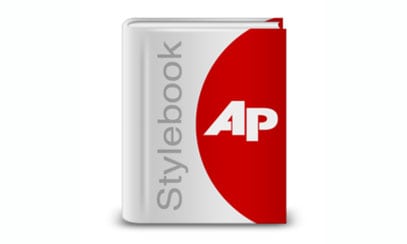
Due respect to your particular dogma and its respective sacred text, certain vocations have their “Bibles” that most adherents should have readily available.

For the IRS, it’s the Internal Revenue Code. For civil servants, it’s the Penal Code for each state. For most creative directors, it’s High Fidelity, Short Stories with Pabst Blue Ribbon, or something like that. For most C-suites in our industry, it’s Good to Great or something Oprah blessed at one time during her heyday.
And for most professionals in public relations, it is the Style Guide of the Associated Press.
This hallowed text is updated annually forcing all of us to buy a new copy at the turn of a new calendar for what ends up becoming six-and-a-half new words and a couple edits to current ones we overlook. We all need it. We all crave it. And few of us understand all of it.
Oh sure, we try to feverishly rummage through every page risking life and limb because of paper cuts, but there are the random few tips that escape us every year. Those hidden gems could become the difference between earning a reporter’s respect and deserving a ‘PR Crappy Pitch of the Week’ note in the media break room.
(And yes, they have those.)
The goal here is to provide each of you some hidden gems on your quest toward AP supremacy. And if that is a skosh too hyperbolic for you, then maybe it’ll just keep you off the bulletin board in the break room.
1. AP Cares about PC – Whenever you find using a questionable term that other folk find “offensive,” err on the side of caution because the AP logophiles already have. In 2013, AP expanded its phobia list and banned the one everyone uses incorrectly: homophobia. Speaking of, “partner” is no longer necessary, and people south of the border are not called “illegal immigrants,” because – much to the chagrin of certain political persuasions – the act of immigration is illegal, not the person.
2. “It’s a Tree, Not a Forest” – This is what I tell every person who screws up my surname. Why do people gain a sense of sympathy and feel that I need an ‘s’ attached to my last name? I wasn’t neglected as a child and was allowed to watch ‘R’-rated movies at the proper age. For the love of Strunk & White, it’s W-O-O-D, not Woods! Likewise, according to AP, any word ending in ‘WARD’ follows the same guideline. Upward, Downward, Toward, Backward, Forward, Sideward – none of them need an ‘s’, and if they are given one for fear of neglect or abuse, you will incur the wrath of copy editors everywhere. And that’s some abuse you don’t want.
3. Symbols Suck – What harm will it do to use ‘%’? Your client has a sweet survey, so percentages will make up a good amount of space, and you are trying to save on word count. Spend the extra 15 cents and spell out p-e-r-c-e-n-t. Yes, always. And you know that cute Microsoft superscript when you type 3rd? Yes, symbols suck. If you have a date, that is a number. If you have a list, the third of whatever is spelled out anyway.
4. College-Aged Girls Killed the Comparison – No kidding: I have been in a spirited debate with a PR director because I used the word ‘like’ in a press release. Why? Because he hated the word. Yes, the work of uptalkers and vocal crutch addicts ruined a good sentence structure. If you can substitute “for example” into a sentence, then use “such as.” The word “like” does, in fact, compare things, like examples in your trusty AP Style Guide.
5. The U.S. is Not a Place – Seriously. We do not live in the U.S. The name of the locale is the United States. Our country or nation, if you need. Whenever you are forced to use this distinction in a sentence, just remember that – or, U.S. is not a noun; it’s an adjective.
6. Read Between the Lines – Did you know that horizontal lines in a sentence have names? There are hyphens and two types of dashes: the en dash (–) and the em dash (—). Hyphens link two or more words together. The en dash shows range, like dates or page numbers (see what I did there). The em dash is similar to parentheses to create an additional thought to be added within a sentence. Oh yeah, there is also a minus sign but if your client is a mathematician, you have bigger fish to fry anyway.
7. BONUS: The Oxford Comma – The Chicago Manual of Style and The University of Oxford Style Guide recommend it, while AP Stylebook leaves it out. There have been fewer countries declaring war over religion than people opening a can of whoop-ass in the cubicle farm because of arguments over this dreaded piece of punctuation. For the sanctity of everyone in your agency, just allow the editor of your paper his or her proclivity for this stupid pausing agent and live to write another day.
Shawn Paul Wood is a 20-year veteran of traditional and digital public relations, as well as a former radio news director and on-air talent. He is a managing account digital strategist for Ketchum PR. Follow Shawn: @shawnpaulwood
For more information about being a better PR writer, check out PR News' Writers Guidebook, available now.

It’s interesting how point one discusses avoiding offensive language, then concludes with a jab at those of ‘certain political persuasions’.